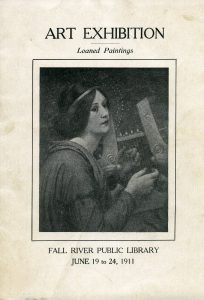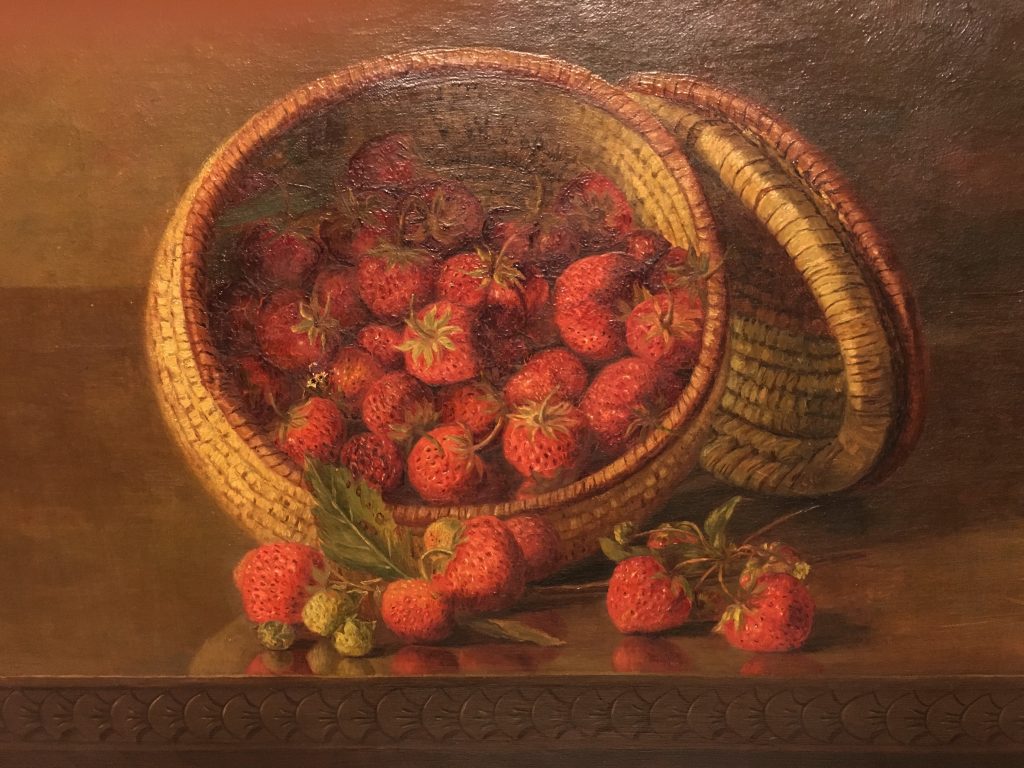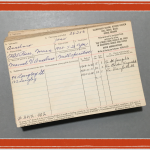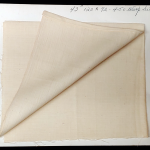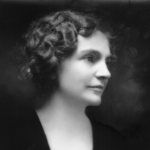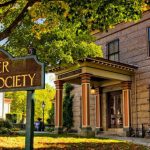It was sometime in the early 1980s that I first saw the painting, hanging on the east wall of the east room of a house within walking distance of the FRHS – it was a lovely house, built in the back garden of the original family residence by the unmarried daughter. It was commissioned by her after “Mother” died and the big house, to the west, was sold.
In fact, the exterior of the smaller two-story house – French country-like in style, with a stucco exterior – belied its interior, which was designed by the architect cousin of its owner as a sort-of smaller version of the much larger three-story family home. The new house was surrounded by a garden with boxwood parterres and brick walks, and was filled with family pieces and fixtures removed from the big house – whether they quite fit, or not.
Not to worry – one could adapt in some ways, regardless how maidenly ridged. And believe me, the maiden-of-the-old-school lady of the house was certainly that.
What she wanted, she most often got.
For example:
An heirloom chandelier:
To make it fit, the two top tiers were removed from the rather grand mid-19th century French fire-gilded-bronze gasolier, hung with long faceted crystal pendants. It had been in the family for three generations – originally installed in a high-ceilinged “Mansion House” on North Main Street – and, of course, had to go into the new house. Yet, despite the alterations, it dominated the small, much lower ceilinged, dining room where it was reinstalled, and hovered menacingly close to the table. But it was lovely.
Luckily, the top tier components that had been removed were stored in the back of a bathroom closet, where they were discovered decades later. Reassembled, the fully intact chandelier now hangs in the FRHS. Yankees save everything – in this case, fortunately.
An heirloom window:
The impressive stained glass window emblazoned with the family crest – a statement piece, for sure – had originally been designed for the grand stairway of the big house, and, of course, had to go into the new house. It fairly overtook the wall of the breakfast room into which it was installed, and was rather incongruous, beautiful though it was. But it said much.
Heirloom tiles:
Hand painted delft tiles – carefully removed from a fireplace slip in the big house – were reinstalled in a bedroom fireplace. Of the many fixtures removed, they were, perhaps, the best suited to their new environment.
An heirloom tall-case clock:
My favorite feature was designed to receive the family tall clock. The ceilings of the new house were considerably lower than those in the big house – in order to provide the necessary accommodation, a serpentine niche-like indentation was created in the first-floor hallway ceiling, providing the necessary height.
Rather ingenious, that.
The maiden-of-the-old-school lady of the house possessed exquisite taste, to be sure – she could easily have been a decorator, and a successful one at that – and spoke faultless French, but she could, at times, be notoriously difficult, as anyone acquainted with her knew. If they did not, they found out fairly soon.
She could be tough.
But she had many redeeming qualities, too, had done a great deal of good, and could be very generous, but this largess was often obscured by qualities not quite as redeeming.
Over the years, I came to know her rather well and put up with many an episode – interesting stories, those. Eventually, I met her sister, who had married decades before and moved out of state, and, in turn, also came to know her well – we corresponded for several years.
It was through the latter – told in veiled references at first and later, much more direct – that I heard the story of the former, and eventually came to sympathize with Miss X, and to understand why she became the way she was.
Suffice it to say that hers was a story of young love played out in Europe; it culminated in an engagement broken per order of “Mother” – no member of that branch of that once-illustrious Fall River family would ever marry beyond the pale. A relative was immediately dispatched to bring the misguided girl home – with tragic results.
She alone of her siblings never married, so duty decreed that she would spend decades as a companion to her rather domineering mother, who was unable – or more likely, unwilling – to accept that the Fall River that was her supposed birthright had changed, and, at least to her, was no longer recognizable.
And so it came to pass that some of the imperious traits possessed by “Mother” were assumed by the daughter, who was fortunate enough – or unfortunate, depending on your outlook – to have the means to indulge them for the remainder of her days.
Perhaps if it had been necessary for her to really earn a living, things would have been different. There were stints as a teacher and, of course, “War Work” at Truesdale Hospital, but these occupations were fleeting – the role of club woman, and director of charitable organizations suited her best; she served on the board of the FRHS for decades.
In her case, just enough inherited wealth – with a disposable bit extra – coupled with an imperious mother and the “misguided” folly of young love, proved somewhat of a curse.
Despite her faults I grew to be fond of her. I remember a small luncheon Miss X gave at the Quequechan Club – she was the faultless hostess, absolutely delightful, and really enjoyed herself. It was a very good day.
On my annual visit to Oak Grove Cemetery, checking the graves of my old friends to be sure everything is in order, the final resting place of Miss X is one of my stops. Mrs. Brigham started the custom – “I’ve checked the graves, Michael,” she would say – and when she was no longer able to do it, I assumed the role, reporting back to her. Now Mrs. B’s grave is the first on the list.
But I digress … enough about graves and the maiden-of-the-old-school lady of the house.
This is supposed to be about a painting.
So, what of the painting that hung on the east wall of the east room of the house set in a garden?
It, too, had come from the old family home and, like the many fine things – and a few, not so choice – that surrounded it, had been in the family for generations. I later discovered that by the time I saw it the painting had already descended in her family for three generations.
It was a still life of strawberries – clearly native, ripe, and sweet – about to spill from a woven, two-tone basket of the sewing variety, onto a polished tabletop with a carved edge, very much in the manner of the Fall River School.
And I freely admit that I often looked at it – studied it, actually – while she rambled on, which she sometimes did. There was no signature evident on the face of the canvas. Was it concealed, perhaps, by the frame liner?
Damn!
Of course one had to look discretely, oftentimes feigning interest in what could be a one-sided conversation. She would have thought it terribly rude to have her possessions – heirlooms, most of them – examined by someone seeking distraction from a not-always-interesting conversation. The mind does wander, and there was, on occasion, a slight panic on my part when expected to provide the suitable answer to a question that I did not quite hear.
Who, I wondered, had painted it?
The artist clearly had talent, though the perspective was somewhat naive – the basket and lid balanced at an incongruous angle – but the fleshy red fruit, textured with small seeds, was beautifully rendered, heightened by light reflecting from the delicate skin. The clusters of berries in the foreground were realistically drawn, with fruit – ripe and unripe – still attached to sections of the plant from which they were picked, with blemished, sawtooth-edged leaves, stems, and tendrils reflecting in the highly-polished surface of the tabletop.
I am very fond of strawberries – the native variety, not the supersized, tasteless, supermarket type – and would have gladly devoured these.
At some point, when I knew her well enough to ask questions, I inquired about the artist.
“Miss Cooper,” came the reply.
The name was, at that time, completely unknown to me.
“Who,” I asked, “was Miss Cooper?”
“I don’t know.” The reply was delivered in a tone that I by then recognized as a directive not to ask any more questions.
Mental note:
Find out more about “Miss Cooper.”
And – no more questions!
So, for nearly two decades, I often looked at the painting when I visited – all the while hoping that it would someday become part of the FRHS collection.
And eventually, this came to pass.
But what of “Miss Cooper”?
Research – intermittent at first, and now, far more earnest – is providing an interesting narrative.
Cara Dillingham Cooper, born in 1851, was a native of Beloit, Wisconsin, the youngest of the six children of Samuel Beach Cooper, a farmer. Little is as-yet known about her childhood.
By 1870, the Cooper family was residing in Vermont, where the nineteen-year-old Cara was listed as “at home,” an indication that she was unemployed and residing with her widowed father; he died four years later.
By 1880, Cara had arrived in Fall River, where her sister, Mary Augusta – fifteen years her senior and unwell – resided with her husband, Reverend William Wisner Adams, prominent pastor of the First Congregational Church. His congregation included members of the city’s most influential families – socially and financially. The Adams parsonage was a large three-storied house fashionably located on June Street, just west of the church edifice.
Cara was quickly accepted into the community, actively participating in social and philanthropic affairs. It was later said: “The best part of Miss Cooper’s life was given to Fall River. Here she was well-known and greatly loved … friends [were] many and more numerous here than in any other community. Wherever she went [she] made friends.”
Following Augusta’s death in 1891, Cara, who undoubtedly had assisted her sister in managing the Adams parsonage, assumed full duties. She became “the mistress of the manse, for many years” being “a great favorite among the people of the … church and indeed in much wider circles. Everything which would fall to a pastor’s wife to carry in mind she bore with her heart, making herself a counselor and comforter of those needing such help from a faithful and wise Christian friend.”
But what of her art?
That she possessed a natural talent goes without saying, but what instruction did she receive, in what mediums did she work, and what was her output?
At the time of her death it was noted: “She was greatly interested in works of art and was active in, if not the life of, the [Fall River] Art Club, which centered in the First Congregational Church, but which had … members from other church connections.” In fact, she was one of the founders of the Art Club, and was its mainstay, assisted by her brother-in-law, “who did much for [its] support as a guide and instructor.”
She “was especially interested in the Art Class, which, through her efforts and talent, became a well-established and instructive organization.”
Her “talent” … this is a rare indication that alludes to her work as an artist.
And there is this:
In the 1880 United States Federal Census, her occupation is listed as “Picture Artist.” Clearly, at that period, Miss Cooper considered herself a working artist, yet of her work we know very little.
To date, the only signature oil-on-canvas work that has surfaced is this painting depicting a basket of strawberries, clearly signed on the reverse of the stretcher “Cara Dillingham Cooper 1885.” The painting is exceedingly rare.
An extant exhibition catalogue documents that ‘Basket of Strawberries” was shown at least once during the artist’s life, in the Art Exhibition of Loaned Paintings held at the Fall River Public Library during the Cotton Centennial celebrations in June, 1911. The picture hung in a gallery with an extensive collection of paintings by “Fall River Artists.”
Interestingly, Cara’s brother-in-law, Rev. Adams, was a great art lover and had amassed a personal collection that included paintings by artists of the group known as the Fall River School, several of whom were personal friends. Among them was the brilliant painter, Robert Spear Dunning – founder of the group – noted for his luscious still life compositions that epitomize Victorian extravagance.
Adams was a close friend and confidant of Fall River native Mary Lizzie Macomber, a brilliant – though troubled – pre-Raphaelite style painter, who received her early training under Dunning’s tutelage; several of her important allegorical works hung in the Adams parsonage.
Thus, the art-loving Miss Cooper was surrounded by paintings and frequently in the company of artists, and she likely reveled in it.
In the paper “Early Painters of Fall River,” read to members of the FRHS at the Parish House of First Congregational Church in 1944 by Ethel Stewart (French) Lovell – a niece of Robert Spear Dunning – there is one brief reference to Cara Dillingham Cooper. When discussing the exhibition of loaned paintings held at the Public Library in 1911, the author states: ‘there were many fine paintings by local artists shown at this time” – among the list of artists is “Cara D. Cooper.”
Following the death of her brother-in-law in 1912, Cara “attended to the closing up of the affairs of the household” in which she had lived in excess of thirty years, and relocated to Maine, residing with her widowed sister and unmarried niece.
Rev. Adams had been close to his sister-in-law and generously remembered her in his will. To her he gave the bulk of his $17,765.89 estate – less $1,000 in bequests to nieces and nephews, ensuring that she would live in comfort.
She died in Maine in 1919.
But there is much more to discover.
Last week, I successfully made contact with a lateral descendant – the great-granddaughter of one of Cara’s brothers – coincidentally a retired professor of Art History, and an inquiry has been made to the extended family.
It is already producing results.
Update to follow.
The painting, by the way, is with a conservator in Boston, undergoing cleaning and restoration to a minor puncture in the left center of the canvas.
And so, when Miss X passed away, the painting went to her nephew, and following his death, to the FRHS though his widow, who said, “I always thought it should have been here in the first place.”
And a bit more about Miss X, in whose home I first saw the painting.
I have attended countless memorial services in my many years with the FRHS, but I will never forget hers.
Not for the large crowd, nor for the eloquence of the words spoken by the minister who officiated – if truth be told, he knew very little about her, evidenced by his eulogy. Her minister was unavailable and did not preside.
It was because of the flowers, that is, one arrangement in particular.
There were many floral tributes of the type one would expect, sent by family and friends, or from the organizations in which she had been involved. Some were grander and more expensive than others – testament to which the sender regarded the deceased, I suppose – the work of many of the leading florists in the area. Most had cards with the sentiment of the sender.
But there was one – the simplest of all – that made the most impact and, I think, was the most heartfelt.
It was a clear glass jar – of the mayonnaise type – with a selection of June flowers, plucked from a garden, clearly evidenced by the rough stringiness of the stems. The garden of origin may well have been hers.
The arrangement had no card with a handwritten or pre-printed sentiment.
Nor did it have to.
It was the anonymous tribute of someone who treasured the memory of the deceased, and remembered her as best they could, perhaps with flowers gathered from her own garden.
It said much.
In its simplicity, it surpassed all others.
Clearly, Miss X had been kind to someone.
Very kind, I should say.
Oh, yes, this maiden-of-the-old-school may have been difficult at times.
But …



